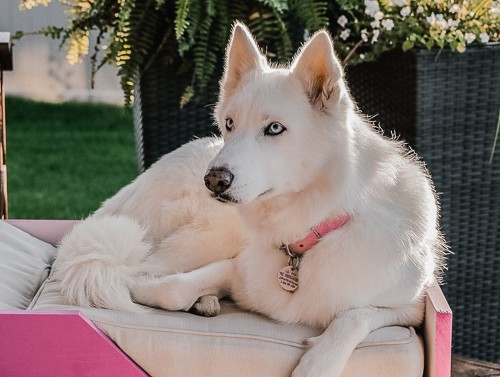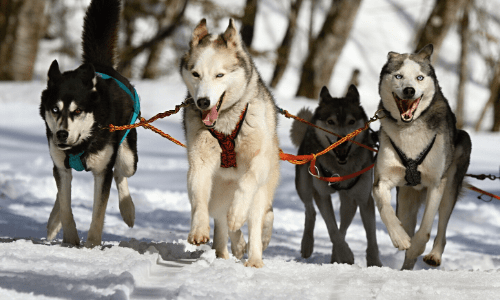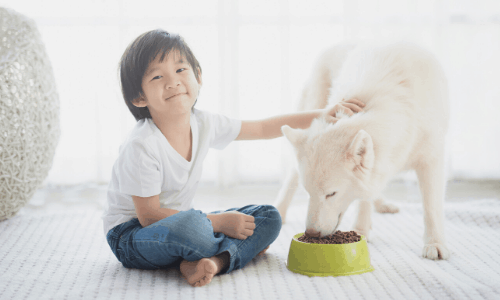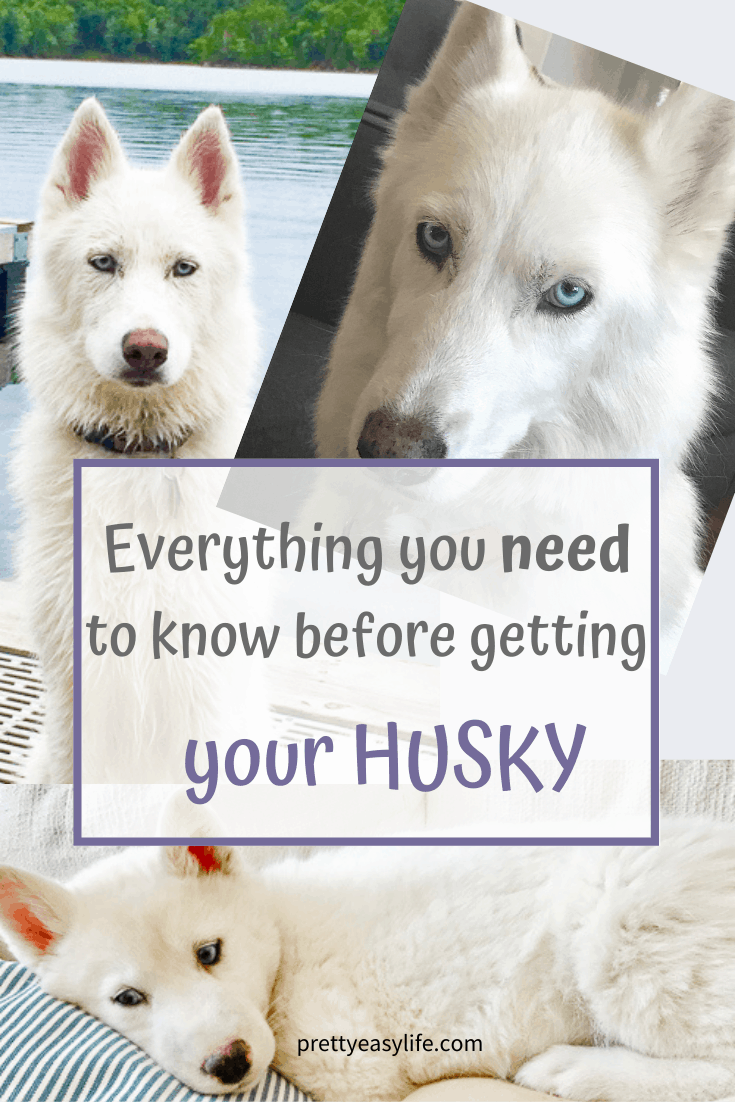What you Need to Know if you’re Planning to get a Husky
If you’re planning to own a Siberian Husky take a few minutes to read this article.
I am not saying this to discourage you to own a Husky. Quite the opposite, I love them to death and own 3 precious ones. We call our home as the Crazy Husky House and I am pretty sure I can share things that only a Husky owner can understand.
There are not bad things about Huskies, they’re adorable, gorgeous, fun, intelligent and loving dogs, but being high energy, it is not a breed for everybody. Siberian Huskies are nor agressive, they’re strong and friendly, smart and make good pets. Siberian Huskies are gorgeous puppies and you’ll fall in love in 2 seconds.

Siberian Huskies are an amazing breed. Everybody loves Huskies.
Understand where Huskies come from
Huskies are fascinating dogs also because of the history behind the breed. Although is not my intention to bore you with too much historical information, learning the breed’s origin will help you to understand many of their behaviors.
Siberian Huskies originated in Northeast Asia where they were bred by the Chukchi people for sled-pulling, protection, and companionship. With the help of Siberian Huskies, entire tribes of people were able not only to survive, but to venture into exploring new territories.
The Siberian Husky, Samoyed, and Alaskan Malamute are all breeds directly descended from the original sled dog. It seems that the term “husky” comes from the nickname “Esky” once applied to the Eskimo and subsequently to their dogs.
William Goosak, a Russian fur trader, introduced them to Nome, Alaska during the Nome Gold Rush, initially as sled dogs.

The story is very interesting. This group effort of several sled-dog teams and mushers were able to deliver diphtheria serum from Nenana, to Nome, where people were in desperate need of the medication. They covered 600 miles over rough ice, across treacherous waters, through Arctic blizzards in the winter of 1925. These 150 dogs were considered as heroic as the 20 mushers. The most famous was Leonhard Seppala with his lead dog Togo.
After this event the exportation of Huskies from Siberia increased.
Siberian Huskies served in the United States Army‘s Arctic Search and Rescue Unit of the Air Transport Command during World War II and were extensively used as sled dogs by the British Antarctic Survey in Antarctica between 1945 and 1994.
Even after the advent of the airplane, dog teams continued to be widely used for local transportation and day-to-day work, particularly in Native villages, according to this article written by Don Bowers in 2012.
They also started racing in sled dogs competitions, such the famous Iditarod race, in Alaska, which started with the goal of “preserving the sled dog culture and Alaskan huskies, which were being phased out of existence due to the introduction of snowmobiles in Alaska; and to preserve the historical Iditarod Trail between Seward and Nome.”
Since 1973, the race has grown every year and has become so well-known that the best mushers now receive thousands of dollars a year from corporate sponsors. Dog mushing has recovered to become a north-country mania in the winter, and some people now make comfortable livings from their sled-dog kennels.
Husky Facts People Should Learn Before Owning a Husky
- The #1 fact is the most important, in my opinion: Huskies are high energy dogs, athletic, their bodies and metabolism are designed to run and explore and THEY DO NEED lots of physical activity. If you can’t provide it, you should re-consider owning a Husky. Without the necessary amount of exercise they are bored and will cause lots of trouble in the house, they will become destruction monsters, literally.
- #2 – From the owner’s perspective, the second problem you can find is that, Huskies don’t listen. It depends on their personalities of course, I heard and saw very well behavioured ones but in general, they really don’t “like” to be told what to do.
Generally all dogs can be trained with consistency and patience. For Huskies though you will need to double or triple the amount of effort when training them. With our 3 Huskies we managed to get mostly the basic commands. The “come” doesn’t happen as often as we would like. It seems it is still optional. Sigh…
- The #3 most important thing is that Huskies are escape artists. They are explorers and runners and curious and free. You need to make sure that your backyard is well fenced and be careful with opening doors. We have countless stories about our adventures going after them, in dangerous situations. We do have high fences in the backyard and have husky-prooved the whole area around the fence because they’re also very good diggers. It’s a good idea to microchip your Husky and get a tracker as well. Trackers come in all prices and sizes, for us, with 3 dogs we had to invest in this one, which also has the best reviews. So far is working great and we can track them on our iPhones. It seems is only compatible with iphones.
- Feeding a Husky is easy, they’re not food oriented, they stop eating when they’re full and give up food for a toy or a walk. Fish seems to be the top food preference. You can find more information here.
- They’re one of the cleanest breeds, they actually clean themselves, like cats.
- They’re difficult to leash train, naturally bred to run and pull, it will take at least a couple of years for you and your Husky to be able to enjoy a pleasant and calm walk in the park.
We had to hire a trainer who taught us how to walk them with a gentle choker chain and it has been working great with the 2 older dogs. The younger, Mary, 2 years old, still pulls and fights a lot even with the choker.
*Please note that you need to know how to walk a dog with a chocker chain to be able to do the trainming without hurting the dog.
- They don’t bark, or rarely do. They haul, sing beautifully and talk a lot. A Husky’s howl can be heard up to 10 miles away. We have endless discussions with them arguing about what they want to do. It’s lost of fun.
- Huskies love to dig, they’re actually professional diggers and small-prey oriented. Since they can run so fast, baby rabbits and other creatures have a hard time around them.
- They are stubborn and headstrong. Huskies can keep asking for the things they want until… you give up. That’s our case.
- Potty training has to be well planned. You do need to put the time on it. Take the puppy out every hour for the first 3 months, if you want to train them as fast as possible. That was the only part of training in which we have excelled with our 3 ones, but it was really lots of work for the first months.
- Huskies have a pack mentality. These dogs need companionship to thrive whether it is in the house ot outdoors. They’re always, always with you and do love to cuddle. This is another reason that owning more than one Husky makes sense. You will never feel lonely with your Husky. He/she will follow you everywhere and will have no problem being comfortable on your sofa or bed.
Last year we got our Furbo camera as a way tointeract with them when we’re away. We keep them crated in the front hall and the camera monitors what they’re doing. It’s great fun watching them and talking to them. When we’re away though, feeding them treats with the camera doesn’t work so well. They get too excited and jump on the gate. But when one of us is away is a fun way to play with them and release the treats. It was worth the investment for us.
- Huskies are great with kids. It’s known that the Chukchi people – indigenous Eskimos of Western Chukotka – use Siberian Huskies to look after their children. They’re really a family dog but don’t do well staying alone for many hours, even if crated. None of our Huskies did well in the crate but again we’re not the best trainers.

- I’ve heard about some scientific studies showing that Huskies show a response to human tears and naturally want to comfort people who are upset. I couldn’t find any of these evidences when writing this article but my experience is that they are very observant and can respond to subtle signals – such as body language – from their pet parents. In my experience, every time they sense I am sad or not well, I get priceless attention and kisses from them.
- Huskies can serve as trained therapy dogs. It’s said that they can even can detect changes in the human body such as a drop in blood sugar or the onset of a seizure. I just can imagine the amount of training they will require for that …
- Although Huskies are not huge dogs, their bite is powerful. They will never hurt their family members but will literally destroy toys. You’ll need strong toys to entertain your dog.
- Don’t count on your Husky as a protective dog. If someone breaks in your house, the person will be happily greeted by your Husky. In 5 min he/she will become best friends with the intruder.
Husky Metabolism and Physical Characteristics
Husky males typically grow to be 21-23.5 in in height from ground to shoulder, and weigh between 45-60 pounds. As they age, the weight goes a bit up, so you’ll have to keep them active. Females are usually smaller standing at 20-22 inches high from ground to shoulder, and weighing in at 30-50 pounds.
They have a cute snow nose – a pink marking on the nose that can disappear in the summer and reappear in the winter. They also have an extra eyelid. The nictitating membrane or “haw” is a layer of tissue that keeps their eyes moist and protected.
Their whole body is designed to endure the cold temperatures (as low as -76 degrees Fahrenheit): the usually wet nose of a Husky dries up at night to protect it from freezing in colder climates. They can regulate their metabolism. This means that while humans use up energy while exerting themselves, Huskies are able to alter this process resulting in them never becoming fully fatigued. The result is that your Husky will be always ready for more activity. When they sleep is because they’re lazy or bored.
Husky Maintenance
One of the prettiest parts of a Husky is their thick coat. Everybody loves to touch them, to cuddle with these soft balls dogs. But… you have to be ready to the shedding! It’s a lot.
Their undercoats are vital to protecting them against extreme temperatures and for this reason should not be shaved unless it is medically necessary. The Husky’s top coat is waterproof and reflects heat in the summer. So, yes, they do ok in warmer climates, although they will really enjoy your AC in the house in the summer.
Ideally you should start brushing your Husky as soon as possible and daily. Owning a good quality brush and strong vacuum is a must. It’s a whole new experience to keep your house nice and neat when having any dog, but especially with Huskies. You’ll probably have to vacuum the house more often than anybody else. I do every day, it can’t be helped.
I take our Huskies for a complete bath with the groomer every 6 months or when it is really necessary, to avoid the drying out of skin and fur. In the summer we bath them at home, using a special Furminator shampoo that fights the shedding a bit. A little bit goes a long way. Don’t forget that their nails have to be trimmed at least once a month. If you start early enough they will get used to it and the job can be done in 10 min. You will need a good nail trimmer (this one has the best review rate on Amazon) for that and some of his/her favourite treats.
Feeding a Husky is simple and easy. As I mentioned before they are not food oriented and can easily be fed once a day. It’s been said that they are lactose intolerant but this is not the case with our 3 Huskies. We add some Homemade food to their kibbel every day and they’re very healthy.
It takes some work but I refuse to feed them store bought wet food. For their kibbel, top quality ones cost more but it is worth every penny. Our dogs are on this food (Acana) since they were puppies and we never had any problem.
Huskies are playful and normally love toys. However their prey instinct takes over and toys don’t last long. I am always looking for super strong toys, ropes, balls that are resistant enough to survive for a few months.
Owning a Husky is a commitment for 11 to 13/14 years, which is the expected life spam of this breed. Think of it before you commit. Think of what your life will be like in 10 years to make the best decision for you and your dog. I see several ads of people selling their 1 or 2 years old Huskies because “their lives have changed”, they have to relocate or changed their minds about their lifestyle.
There are lots of Huskies up for adoption because many times people can’t deal with their needs, lacking time to spend with them, space or patience. It breaks my heart to see the amount of ads of so many dogs waiting to be adopted.
It takes the right personality to own a Husky. If you’re a neat freak and a clean and tidy house is very important for you, maybe this is not the breed for you.
Another option is to adopt a Husky. There are lots of them waiting for a forever home. People fall in love with their looks and are not ready for the challenges of raising them. A grown Husky, fully trained, can be a great option for you too. Husky puppies are irresistible but they grow very fast and reality kicks in. Sometimes is easier to get to know ahead of time how is the dog’s temperament and if it is a good fit for your life.
Final Honest Tips for Future Husky Owners
I owned many dogs over the years, from German Shepards to Poodles and I loved all of them with a full heart. However there is something special and unique about owning Huskies. Maybe it’s the heroic history behind them, the way they look back at you with those beautiful eyes, their unique sturboness or their love for wilderness and freedom. It has been the first time that my husband and I ventured into owning more than one dog and our pack of 3 literally fills our time.
It takes lots of love to own a Husky and that means that you’ll have to devote tons of work and attention but I guarantee that you’ll get everything back twice.
Download here an easy and Free guide to help you pinpoint if a Husky is for you, when subscribing to our content.
Drop your comments and questions and follow us (Turbo, Stella and Mary) on Instagram. We’ll love to hear from you.

